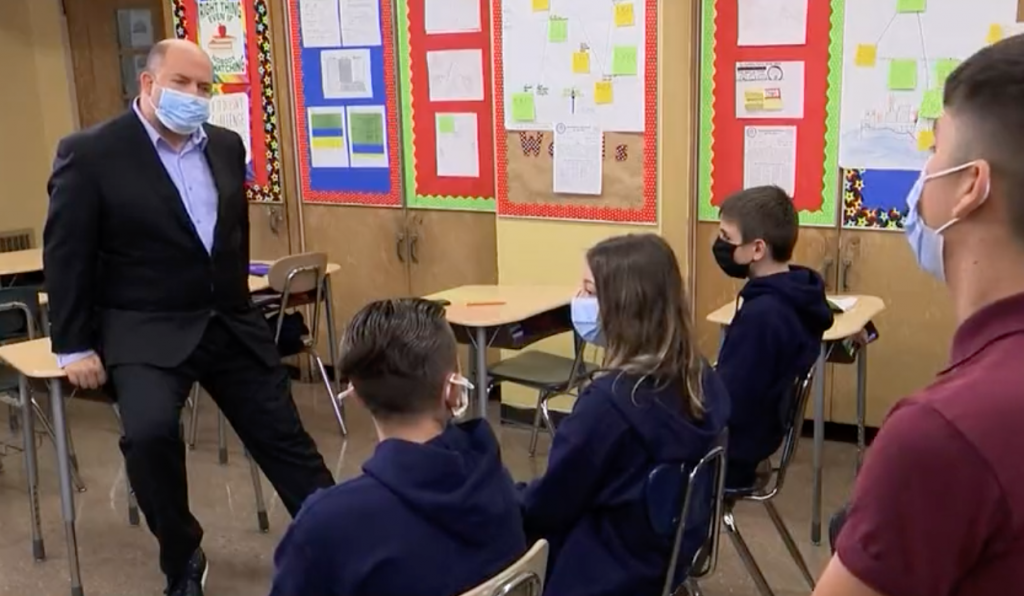See CNN In Classrooms Teaching Kids What Misinformation Is
Misinformation. Fake news. Social media. Mainstream media. They all go hand in hand. Misinformation is running so rampant now that classes are being taught to middle schoolers on how to spot misinformation online and it was in one class that CNN got a good look at how misinformation is being dealt with. It's being dealt with by an organization CNN backs and pushes into classrooms.

Misinformation. Fake news. Social media. Mainstream media. They all go hand in hand. Misinformation is running so rampant now that classes are being taught to middle schoolers on how to spot misinformation online and it was in one class that CNN got a good look at how misinformation is being dealt with. It’s being dealt with by an organization CNN backs and pushes into classrooms.
Barbara King teaches 8th-grade students at P.S. 207 in Queens, New York. She says she has been teaching media literacy for almost a decade and this is where CNN’s chief media correspondent, Brian Stelter, met up with King and her students to talk about misinformation. As King explains, “I feel it’s a skill that my students really need. There’s too much misinformation around us in the world and I want to give them some tools to make sense of what they’re seeing.”
As the news report begins, CNN’s Stelter informs us that “Barbara King wants to arm this eighth-grade class with the tools they will need in a world of information saturation.” From there, King begins to discuss with her class the topic of the day – misinformation. She then tells the class that they will be identifying the various types of misinformation. According to King’s teachings, the various types include satire, false context, imposter content, manipulated content, and fabricated content.
One key moment in the news report came when King asked her classroom what “imposter” meant. She was talking about imposter content as it pertained to misinformation. After one student described what an imposter was, King then went on to explain that imposter content is when someone uses a well-known name (celebrity, athlete), a logo, or a brand in order to fool people into believing what they are peddling is authentic.
The students know and understand what the internet is turning into. They are savvy enough to realize that not everything they see, hear, or read is the truth. As one female student says, “A lot of students have social media and if they’re looking at stuff, that is, like wrong, and just telling everyone that it’s right, they’re just giving everyone false information.”
To help King in her endeavors, she uses a curriculum from the News Literacy Project (NLP). The NLP claims to be a nonpartisan national education nonprofit that, as their website says, “provides programs and resources for educators and the public to teach, learn and share the abilities needed to be smart, active consumers of news and information and equal and engaged participants in a democracy.” Teaching how to spot misinformation is becoming more and more popular as social media continues to dominate our every day. NLP’s founder, Alan Miller, says that more than 37,000 educators across the nation use NLP’s curriculums.
Here’s the full video…
However, it’s worth noting that NLP is backed by some specific organizations which some don’t believe are nonpartisan at all. They’re run by media organizations like NPR, ABC News, The New York Times, Politico, and even CNN. All of those news organizations have at one point or another been accused of having a strong liberal bias. Notably missing from their list of backers are news organizations clearly from the other side of the political spectrum, like Fox News, Newsmax, or The Daily Wire.
King’s classroom then broke down some manipulated content where pictures were merged to make viewers believe what they were seeing was true. They spoke about a picture that has made its rounds every time a big storm hits, that of a shark swimming alongside a car driving on a flooded freeway. The class then spoke about tips on how to reverse search an image to check if the image is fake or not.
King says one of her main goals with teaching the subject is to instill basic critical thinking skills in her class. She feels what the younger generation is dealing with now, all of us in fact, are the real-world problems of misinformation. So many of us are tethered to our cell phones and social media accounts and that is how most of us get our news. And as we all know, information can be easily manipulated to whatever one wishes. It’s worth noting that one of the ways to do that is by labeling correct information as misinformation. It’s unclear whether students are learning about that particular method of media control.
After King’s class ended, CNN’s Stelter sat with the kids for a moment, discussing social media misinformation. One young man explained to Stelter that when COVID first hit, his family thought it was fake because of some of the things they were reading. He also said he wanted to believe it was fake because there was so much information on both sides. The young man concluded that more research is the key to identifying misinformation.
Social media and misinformation. Two peas in a pod. It is getting tougher and tougher to know what is right and what is wrong in the news these days. Maybe a class like the media literacy one being taught in Queens, NY should be taught in every school. You can see CNN’s full report on misinformation here. Pay attention to whether they reveal they’re one of the organizations behind the News Literacy Project.



